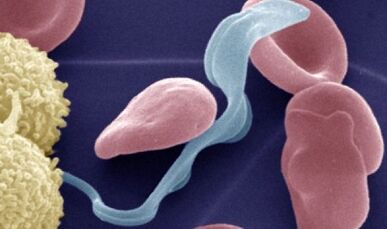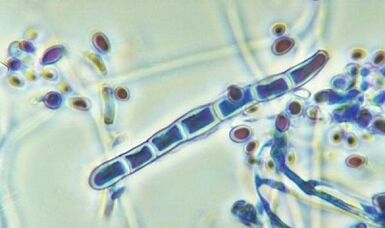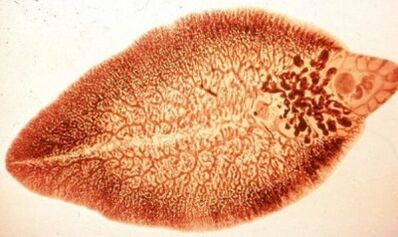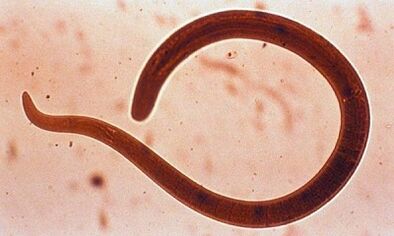Human parasites can inhabit all organ systems. The important activities of worms may be a prerequisite for the development of cancer, and tiny fungi and mites can cause allergies.
The human body can inhabit at least 300 parasites, including bacteria, viruses, protozoa, microscopic fungi, worms (parasitic worms), and single arthropods. These organisms not only consume the nutrients absorbed by the host, but also use the products of their important activities to poison him. According to the classics of modern medicine, the concept of "parasites" does not apply to prenuclear (prokaryotic) organisms: bacteria and viruses. It is characterized by protozoa, fungi, worms, and arthropods that live in the host and only exist in the host.
Microparasites

Human and animal organisms are fertile environments for microscopic fungi and protozoan life. They are indistinguishable with the naked eye, and they damage the skin and internal organs.
Parasitic protozoa
Infections caused by protozoa are called protozoa. This disease is common in tropical and temperate regions. About 50 kinds of protozoa are parasitic in human organs and tissues. They can be infected through sexual contact, food or insect bites.
Giardiasis is very common. As many as 40% of children and 10% of adults suffer from this pathology. The favorite habitat of lambs is the small intestine. Although usually asymptomatic, the disease can be accompanied by digestive diseases and allergic reactions. Pathogens are spread through nutritional channels through undigested water and contaminated food.
According to various sources, 30% to 50% of the world’s population is infected with toxoplasmosis. Its pathogen usually lives in the host organism without any clinical manifestations. Toxoplasma gondii poses the greatest danger to pregnant women: it causes fetal death or severe malformations in the womb. Infections occur through contact with domestic mammals (cats, rabbits, rodents) and eating uncooked meat.
The most common sexually transmitted infection is protozoa. This is trichomoniasis. More than 150 million people worldwide are infected each year. The manifestation of the disease depends on the organs affected. In women, trichomoniasis lives in the vagina, causing inflammation and urethritis. In men, protozoa can infect the prostate, seminal vesicles, and in severe cases can cause prostatitis, although the infection is usually asymptomatic.
Malaria, Leishmaniasis, Chagas disease and sleeping sickness are widely known in tropical regions. Their pathogens are Plasmodium, Leishmania and Trypanosoma. Parasites are carried by blood-sucking insects: mosquitoes, tsetse flies, triangle algae insects. By biting sick animals or people, they acquire and spread the pathogens of these diseases.
Parasitic fungus

About 100 species of fungi are known to be very dangerous to humans. Their best habitat is warm and humid areas of the human body, such as the space between the fingers. However, these organisms can also infect the skin and other parts of the body.
Trichophyton, Microsporum, epidermal fungi cause dermatophytosis: ringworm and psoriasis, variegated feet, scalp, and rarely mucous membranes. The pathogens of these diseases can be transmitted from animals or patients to humans. In severe cases, bacterial infections can cause dermatophytosis.
Mold and its spores are also harmful to humans. They can cause the following diseases:
- Penicillium;
- Myxosis;
- Aspergillosis.
These pathological features are all parts of the respiratory tract inflammation, otitis media, and various allergies without exception. In severe cases, parasitic fungi can cause pneumonia and bronchial asthma. People with weakened immunity and chronic diseases are most susceptible to fungal infections.
Worms
The favorite habitat of parasitic worms is the digestive tract of humans and animals. They feed on food, bile and blood after digestion by the host. All worms belong to the following categories:
- round worm (nematode);
- Flatworms (with worms and and).
Parasites
- liver;
- Chinese
- Giant;
- lanceolate;
- Cat fl lucky.

Sometimes a person becomes infected through direct contact: the larvae of the tropical parasite of schistosomiasis pierce the skin of a person swimming in fresh water, then enter the bloodstream, live in it and feed on red blood cells.
Most flukes affect the liver, gallbladder and ducts of these organs, causing diseases-flukes. Paragonimus lives in the environment of muscle, subcutaneous fat tissue, brain, but most importantly the lungs. The disease caused by this worm is called paragonimiasis. The small fluke metagonium lives in the small intestine and causes metagonimosis.
The scales are very small-their flat fronds do not exceed 10 cm-but the consequences of their retention in animals and humans are fatal. The long-term parasitism of these worms may lead to the development of cancer, liver cirrhosis and gallstone disease.
Unlike flukes, tape worms (ces worms) can grow up to tens of meters in length. The main route of worm infection is food. These worms enter the human body through undercooked meat and fish. The main environment formed by ces worms is the small intestine, in which adults live, while larvae live in substantial organs (liver, lung, spleen).
Among all tape bugs, the following are the most common:
- bullish worm;
- Echinococcus oc;
- Wide ribbon;
- Pork tapeworm;
- Pneumococcal bacteria.
Round parasite
The disease caused by parasitic roundworms-nematodes-ranks first among all helminthiases in terms of incidence. Most adult parasites live in the intestines, but at certain stages of life, they can migrate to the muscles, lungs, heart, and pharynx. In humans, the following nematodes are common:

- worm;
- round bug;
- poison;
- Trichinella;
- hookworm;
- Behemoths.
Round eggs and larvae enter the human body through food and water. Nematodes such as hookworms and iron worms invade the host's body. These worms are mainly found in tropical regions.
The ubiquitous nematodes are pinworm, roundworm and toxoplasma. The former most often affect children and cause small intestinal helminthiasis-the most common helminthiasis. Dogs are carriers of Toxoplasma gondii, although these nematodes can also infect humans. Worms live in humans and are not dangerous to most animals (except pigs).
Arthropod parasites
C, flukes and parasitic nematodes are suitable for living in the internal organs of the host. In contrast, most parasitic arthropods live on the surface of the body. Most commonly, a person is infected with lice and mites, and lice and mites are the pathogens of helminthiasis and scabies. These parasites are dangerous because they can carry pathogenic bacteria and rickettsiae that cause Volenic fever, typhus and recurrent fever.
Lice drink human blood, and parasitic mites live on human skin. The sores itch in their passages, and Demodex live in the hair follicles and ducts of the sebaceous glands. The life activities of these parasites cause allergies, accompanied by rashes, redness and itching of the skin.
The world we live in is developing rapidly, and the standard of living is steadily improving. Today, in the eyes of many people, parasitic diseases are many inhabitants of third world countries. However, population migration has led to the spread of this disease beyond the natural foci. In this regard, it is important to remember the basic rules of hygiene, and following these basic rules will help avoid infection.

























